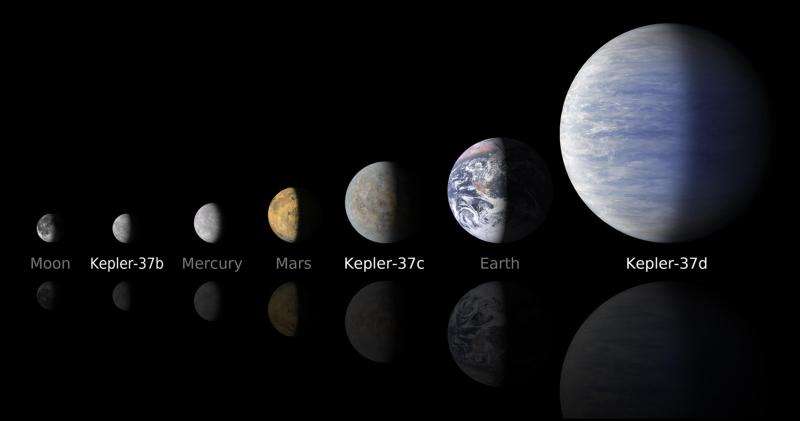It looks like you're using an Ad Blocker.
Please white-list or disable AboveTopSecret.com in your ad-blocking tool.
Thank you.
Some features of ATS will be disabled while you continue to use an ad-blocker.
1
share:
NASA's Kepler Mission Discovers Tiny Planet System:
The planets are located in a system called Kepler-37, about 210 light-years from Earth in the constellation Lyra. The smallest planet, Kepler-37b, is slightly larger than our moon, measuring about one-third the size of Earth. It is smaller than Mercury, which made its detection a challenge.

While life appears to be impossible on this tiny planet due to its distance to its sun (closer than Mercury is to our own sun), this new discovery is very important as it suggests that such little planets are common in the Universe:
Read the whole paper here
The planets are located in a system called Kepler-37, about 210 light-years from Earth in the constellation Lyra. The smallest planet, Kepler-37b, is slightly larger than our moon, measuring about one-third the size of Earth. It is smaller than Mercury, which made its detection a challenge.

The moon-size planet and its two companion planets were found by scientists with NASA's Kepler mission, which is designed to find Earth-sized planets in or near the "habitable zone," the region in a planetary system where liquid water might exist on the surface of an orbiting planet. However, while the star in Kepler-37 may be similar to our sun, the system appears quite unlike the solar system in which we live.
While life appears to be impossible on this tiny planet due to its distance to its sun (closer than Mercury is to our own sun), this new discovery is very important as it suggests that such little planets are common in the Universe:
"Even Kepler can only detect such a tiny world around the brightest stars it observes," said Jack Lissauer, a planetary scientist at NASA's Ames Research Center in Moffett Field, Calif. "The fact we've discovered tiny Kepler-37b suggests such little planets are common, and more planetary wonders await as we continue to gather and analyze additional data."
Read the whole paper here
edit on 20-2-2013 by elevenaugust because: (no reason given)
Cool
I never get why scientists assume for there to be life on other planets, that planet has to be similar to ours? The universe if full of mysteries, who's to say life can't live that close to the sun?
I never get why scientists assume for there to be life on other planets, that planet has to be similar to ours? The universe if full of mysteries, who's to say life can't live that close to the sun?
edit on 20/2/13 by Tumble because: missed word
With these planets being light years away, I can't help but wonder if anyone is working on navigation. Afterall, we are seeing this one were it was
210 years ago. if we could travel at light speed it will still be moving, in some direction, while we are on our way there. Then to return, we wouild
have to know were earth will be when we get back. Or, at least, our decendants.
I don't think I would want to travel that far and miss my home planet, even by a few light years, when I want to go home.
Yes, I know, it will be done by super computers; but I would still like to think they would be super accurate.
Travel on a two dimentional planet presents far fewer variables than in a three dimentional environment with everything moving in different directions and at different speeds.
I don't think I would want to travel that far and miss my home planet, even by a few light years, when I want to go home.
Yes, I know, it will be done by super computers; but I would still like to think they would be super accurate.
Travel on a two dimentional planet presents far fewer variables than in a three dimentional environment with everything moving in different directions and at different speeds.
edit on 20-2-2013 by teamcommander because: (no reason given)
edit on 20-2-2013 by teamcommander
because: (no reason given)
new topics
-
God's Righteousness is Greater than Our Wrath
Religion, Faith, And Theology: 4 hours ago -
Electrical tricks for saving money
Education and Media: 7 hours ago -
VP's Secret Service agent brawls with other agents at Andrews
Mainstream News: 8 hours ago -
Sunak spinning the sickness figures
Other Current Events: 9 hours ago -
Nearly 70% Of Americans Want Talks To End War In Ukraine
Political Issues: 9 hours ago -
Late Night with the Devil - a really good unusual modern horror film.
Movies: 11 hours ago
1
